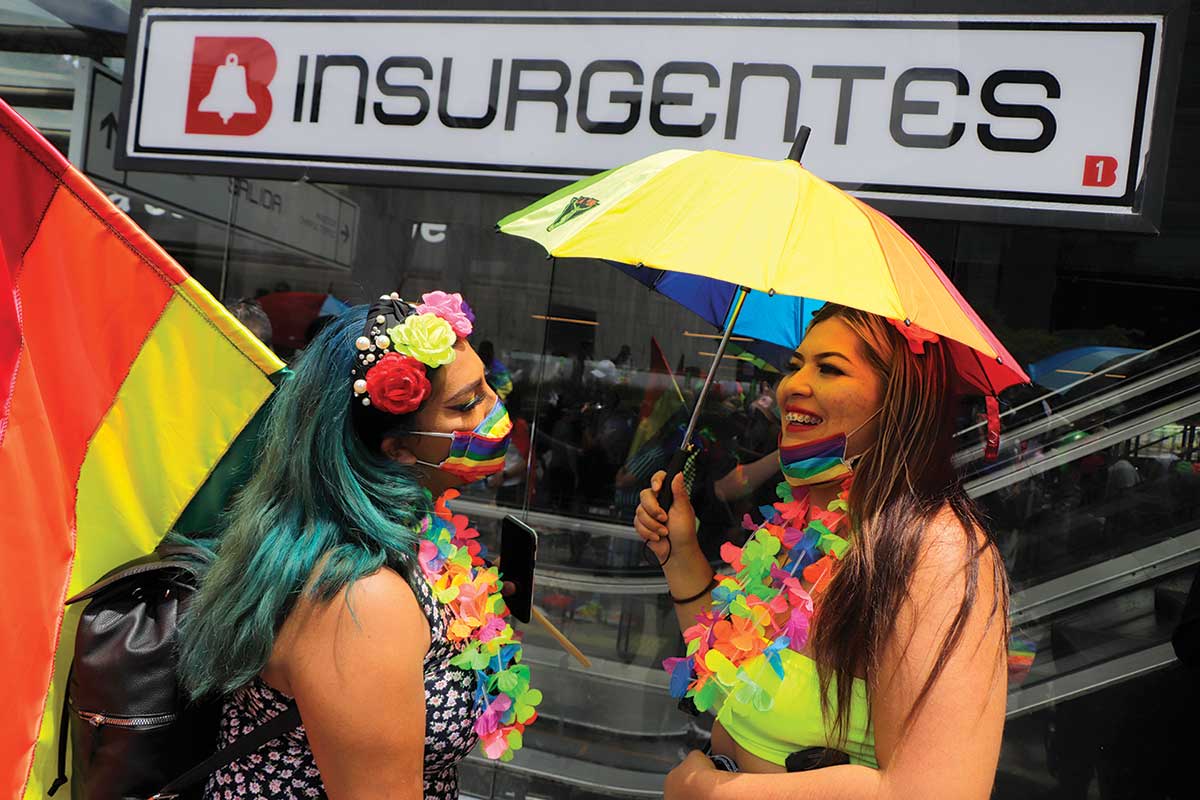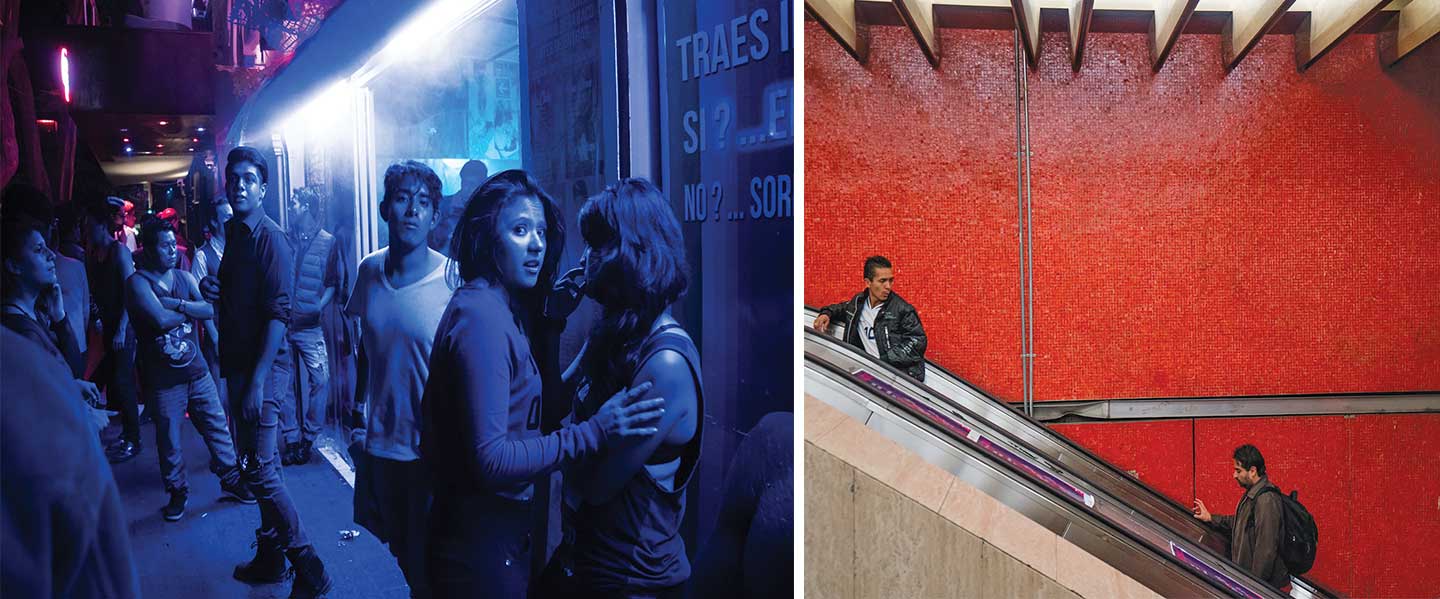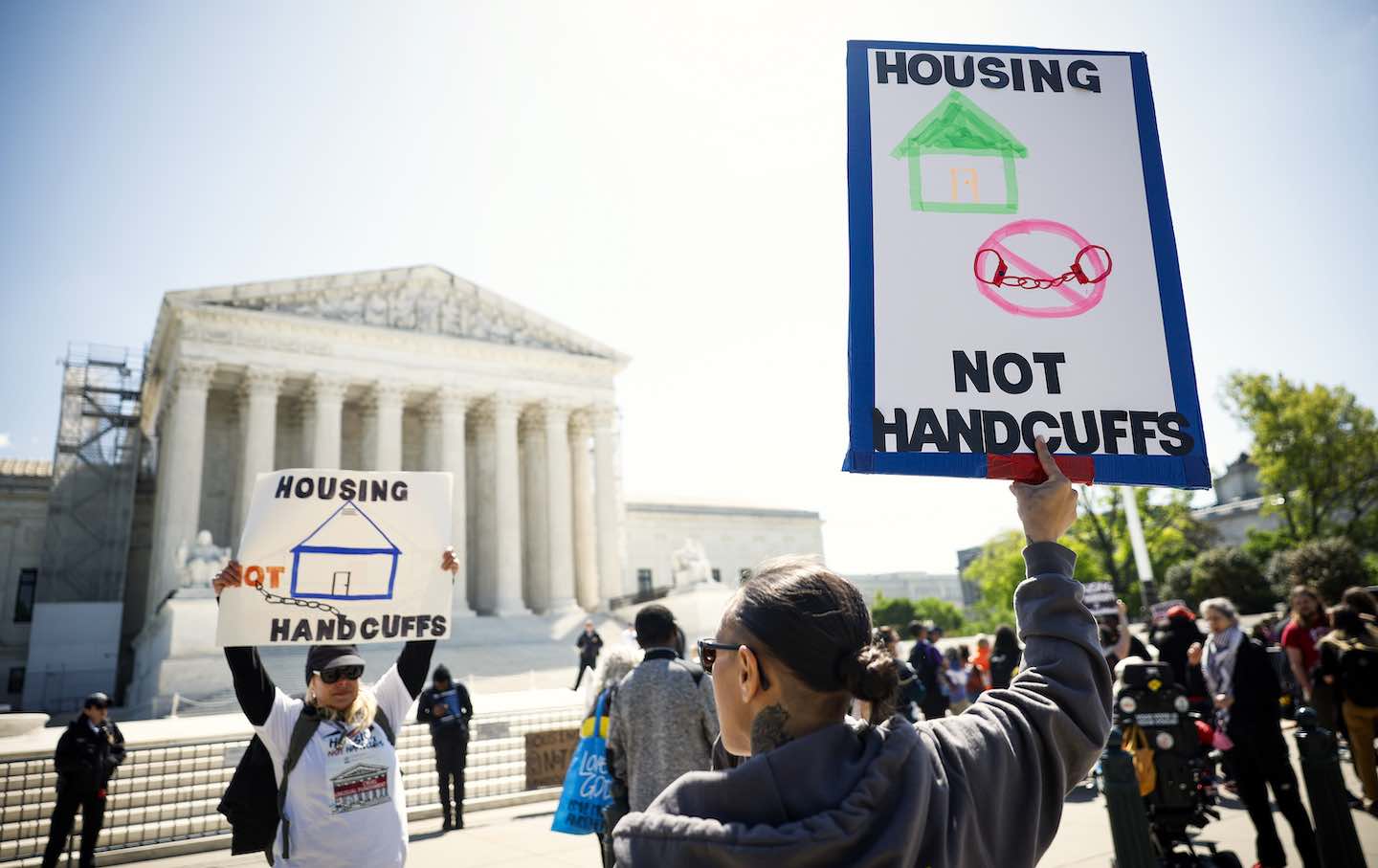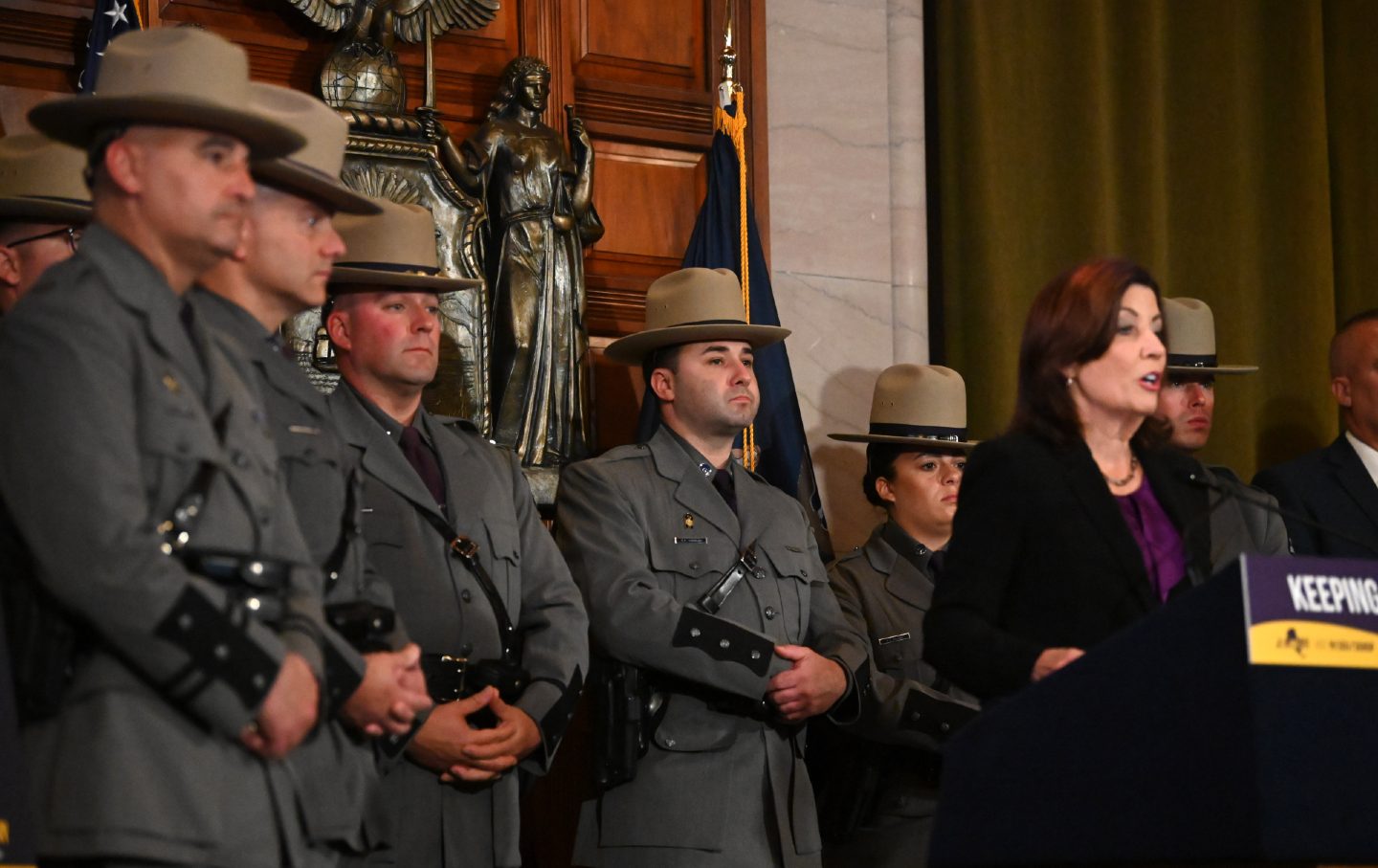The Nonstop Gay Sex Party on the Mexico City Subway
The city’s metro hosts—and authorities unofficially sanction—a queer institution unlike any other.

I had heard rumors about men having sex in Mexico City’s subway system. But nothing prepared me for what I witnessed on my first ride in the último vagón.
It was early afternoon, outside of peak commuting hours. Only a handful of passengers were in the last car of the train as it headed out of the city center and pulled above ground, zooming along the highway. My eyes darted back and forth between a middle-age man in dusty overalls, presumably a day laborer, and a preppy, college-age man in a polo.
The younger man stood with his forearms resting on a handrail. He stared at his phone, slightly bent over. The older man was braced against the door, his hand stuffed into the younger man’s sweatpants. I tried not to stare, but I kept stealing glances to confirm what I thought I was seeing. After a few moments, it became clear that he was masturbating the young man anally.
The older man stared ahead, stony and impassive. The young man didn’t betray any emotion either; he continued to scroll through his cell phone, giggling occasionally, perhaps in response to some novelty on his social feeds. It was as though they were maintaining a kind of public decorum, despite the brazenness of their intimate activity.
The young man bit his lip and clenched his jaw, seemingly trying to conceal a shudder rocking through him—as if he were throwing himself onto a hand grenade, valiantly protecting the innocent bystanders from the pleasure that was exploding inside of him. The train continued, passing the Villa de Cortés station.
I looked around for someone who could make sense of this situation. Only a few meters away, an elderly woman sat with a basket of sunflowers in her lap. A man in a business suit was absorbed in his phone. They could not possibly have failed to notice what the two men had been doing, a paradoxical performance of exposure and concealment. But outwardly, they ignored the episode entirely.

Queer people the world over have found ways to create spaces where they can survive, and sometimes even thrive, in the unlikeliest contexts. But very few have managed to fashion a queer hub out of something that is mobile and woven into the municipal infrastructure. Mexico City’s gay underground has the distinction of being literally underground. The historian Alonso Hernández Victoria notes that gay men have used Mexico City’s subway for sex, romance, and other encounters since it opened in 1969. In the quintessential Mexican LGBTQ novel The Vampire of Colonia Roma, published in 1979, author Luis Zapata describes the subway as the axis of Mexico City’s gay world. For decades, certain stations served as hubs of gay community, and by the 1990s, the subway system had become what the geographers Álvaro Sánchez Crispín and Álvaro López-López called “one of the most popular and visited gay places…perhaps in the whole world.” Since 2000, public male-male sex has taken place in the último vagón almost constantly during its operating hours. Meanwhile, city authorities have increasingly branded Mexico City as LGBTQ-friendly, adorning Metro stations with works by queer artists, even licensing works by the gay US artist and HIV/AIDS activist Keith Haring to cover entire train exteriors. Yet the practices of the último vagón exist in a legal gray area, which keeps many queer people precariously dependent on the largesse of police and politicians.
Most cities do not recognize public sex as a human right; Amsterdam and Copenhagen are notable exceptions. While Mexico City does not explicitly protect the activities of the último vagón (Spanish for “last car”), it does not forbid them either. City statutes that apply to public sex and sex work are ambiguous and open to interpretation by police. Specifically, it is not clear when or if regulations in the city’s civil code actually apply to sex in the last car. Héctor Domínguez Ruvalcaba, a scholar of queer Latin American culture at the University of Texas at Austin, told me that he was reminded of how colonial laws in Mexico often included the proviso “obedézcase, pero no se cumpla” (a paradoxical insistence that the law needed to be “obeyed, but not fulfilled”). The text of Chapter I, Article X, of Mexico City’s municipal code states that it penalizes “the exhibition of the sex organs with the intention to bother or attack someone,” under the specific condition that “there exists a complaint from the person thus bothered or attacked.” The law does not strictly apply to consensual sexual activities, though the police have often invoked this law in order to extort bribes. Meanwhile, the last car has provoked much debate and outcry in the Mexican press, which regularly laments this “open secret.” And now the institution—which some call a paradise and others consider a shame—may be facing a crackdown.

I began to ride the último vagón. My casual exploration quickly evolved into extensive research. Early on, I met Elias in the last car. A gay man in his mid-20s, Elias told me that he had studied photography in college, but since the pandemic he has struggled to find steady work. He invited me to disembark with him, and we chatted briefly on a station platform. Elias told me that, because of his straitened economic circumstances, he had moved back in with his parents, whom he called homophobic. He described himself as an “expert” in the último vagón and had undertaken a thorough study of the city’s subway system.
Elias offered me a list of the lines where there is, as a rule, cruising in the last car—but I quickly realized that he had named nearly all 12 lines in the subway. As the second-largest subway system on the continent (after New York City’s), the Mexico City Metro moves an average of almost 4 million people a day, from 5 am to midnight. The fare for the Metro has been five pesos, or about 25 US cents, since 2013—the system is so heavily subsidized that it has repeatedly been a source of contention between the Mexican government and the World Bank. As Elias noted, this low price makes the last car much more accessible than clubs and bars.
Each line, Elias told me, has its own personality. “On the line that goes to Metro University,” he said, “the last car has more college students.” Other lines suit other tastes: “The coffee-colored line passes through the sports center, so the last car on that line has more jocks.” According to a recent study by the sociologist Andrés Alvarez Elizalde, the sexual activity is especially common during peak hours (when the last car is extremely crowded) and late at night (when the last car is almost empty).
When I asked Elias about the curious scene I had witnessed—the worker anally fingering a student, in full view of people who pretended not to notice—he told me to read the Nobel laureate Octavio Paz. “The last car,” Elias said, “is like what Paz called the Mexican ‘labyrinth of solitude.’” Paz claimed that Mexican national culture is characterized by hypocrisy and loneliness, as people hide their true selves while joining together in public rituals and celebrations. Like many other guys I would meet, Elias said the last car emerged out of what he called the doble moralidad, or “double standards,” of Mexican culture. The last car provides gay men like him with a space of freedom. Elias explained that he had very little money and no privacy at home and that the last car provided a refuge from his judgmental parents.
Many of the men I met on the Metro told similar stories. Miguelito—who is in his late 20s and teaches French—told me he had grown up in a provincial town and moved to Mexico City for college. By accident, he found the last car, and he began to ride in it regularly. He said that exploring the train helped him to come out as gay, “not just sexually, but by seeing gay people talking, flirting, laughing.” He even met his first boyfriend in the último vagón. Like Elias, he described the phenomenon of the last car as having to do with a “double life.” He said that he took pleasure in how he could “rebel against his family’s idea of him as the ideal son.”
A podcaster named La Siguamonta has created an extensive series of interviews about the last car, Ride It Good: Aventuras desde el Último. The thumbnail on La Siguamonta’s podcast shows them riding the train while exposing their bum, and they told me that they used to get dressed up to ride the Metro, as though getting ready to go to a club. They talked about how, after they migrated to Mexico from Guatemala, the last car provided them with a space of community. There is “a social commitment to the último vagón and a philosophical affinity,” they said, insisting that it’s “not just about being a ho.”
Ride It Good describes a complex sexual ecosystem hiding in plain sight, its most intimate escapades on full display but its nuances legible only to those in the know. Men with specific tastes know which lines to ride on in order to encounter their type. Line B, for example, leaves the city proper for the rougher barrios surrounding it, and its last car is known as a place to look for gente mal—rough trade.
As La Siguamonta put it, “There are more intensities on the margins than in the center, where everyone is homogenized.” And the train connects these marginal intensities. In fact, this has been an important role the Metro has played in queer history. As the gay novelist José Joaquín Blanco has written, when the Metro opened in 1969, it connected the working-class barrios with the posh neighborhoods and created cross-class gay relationships that “forcibly democratized” the gay community and turned the whole city “pink”: “The unemployed or underemployed boys from Neza [a rough barrio] arrived in waves of hundreds and thousands, just by getting off the subway.” Tourists, meanwhile, have been coming to Mexico City to enjoy the bustling gay scene—full of bathhouses, discotheques, and movie theaters—and the US photographer David Graham has documented the last car with thrilling photos. One of the city’s sex clubs even includes a replica of an último vagón. But as digital nomads move into Mexico City, very few of them seem to ride the subway.
The recent study by Alvarez Elizalde documented the diversity of practices that take place in the car. Mostly the sex is masturbation or oral, though sometimes there is also anal penetration. Many commuters are simply taking advantage of their daily trek to and from work. Others use the car as a meeting place and migrate the sexual activity elsewhere. A laborer in his 30s named Jesús told me that “Wednesday is my day off, so every Wednesday afternoon I ride around until I meet someone and then go to a hotel with him.”
Not everyone in the last car is looking for sex. Some guys use the last car to seek out dates and romance. And some LGBTQ folks ride in the last car because it feels relatively safer. The first two cars of the trains are for women and children only, in order to protect women from sexual assault. But Rachel Swack, who is researching the Metro from a feminist perspective as a Fulbright public policy fellow, told me that this has turned the middle cars into “harassment cars” that seem to be full of predators. In the last car, I often see lesbian couples, trans women, and others from all stripes of the LGBTQ rainbow. It’s like a daily Pride Parade, full of queer workers, students, doctors, lawyers, soldiers—some having sexual adventures and some just riding to and from work.
Of course, there are gay people in Mexico who object to the practice. Saúl, a middle-aged mariachi singer, told me that he considered the último vagón “shameful” and “without dignity.” Saúl said that the car “didn’t have the romance of the mariachi ballads” that he liked to sing.
Popular
“swipe left below to view more authors”Swipe →But other riders take a more optimistic view. Adam, a doctor from Israel in his late 40s, told me about how he had escaped an arranged marriage and fled to Mexico. When he found the last car, he said, it helped him adjust to his new life. “In the last car,” Adam told me, “you can be yourself.”
Other men find the last car therapeutic. David, a flower salesman in his 30s, told me he had grown up in rural Mexico, crossed the US border, and lived for years with an older partner. When his partner died, David said, he “felt depressed” and decided to return to Mexico. He went to a therapist, who suggested that he ride in the last car in order to make friends. “It’s not like other gay spaces,” David said, “because there’s no drugs or alcohol.”
Although public sex, particularly during the daytime, might seem inherently risky, several people told me that the last car is relatively secure. Elias said that “there’s lots of light” in the car, “so it feels safer” than other gay spaces. A bisexual lab technician in his 20s told me that “in the last car, there’s less discrimination than on Grindr,” where users often reject people because of their race or body type.
Epidemiologists do not yet understand how sex on the Metro affects public health. But HIV/AIDS activists, knowing that it is a site for male-male sexual activity, frequently use the Metro to deliver medicine and educational information.

The último vagón’s legal status became even more complicated following a conflict in 2011 between the Metro’s authorities and the city’s Human Rights Commission. A press report from that year stated that sexual activity on the train “has been an open secret since 2004, when guards from the Metro Collective Transportation System began to detect it.” The Metro announced that it would close the last car of certain train lines during evening hours. Officially, authorities claimed that they were taking this action due to a lack of ridership late at night. But the Human Rights Commission received at least three formal complaints accusing the Metro of anti-gay discrimination. And a subsequent investigation by the commission found that ridership was not lower at late hours, and that the authorities had clearly intended to shut down the last car in order to curtail gay sex. Many station managers and police officers had said aloud what everyone already knew. One cop justified the closure of the last car by saying, “There are many gays, and they do their things.” Another guard described gay sex in the último vagón as a kind of militant invasion: “It’s because of the gays, because they were taking over the facilities…. There are even recordings in which oral sex is being practiced.”
In its subsequent, nonbinding recommendations, the Human Rights Commission argued that the Metro had discriminated against gay people by specifically targeting them, and that the closure of the last car had violated their human rights. The commission recommended that the Metro reopen the last car at late hours and mount a publicity campaign to inform the public about LGBTQ rights. The commission’s recommendations were followed, which gave a quasi-legal sanction to the último vagón. Some gay activists have objected to how the resulting legal confusion promotes discrimination against gay people. Héctor Salinas, a professor of gender studies at the National Autonomous University of Mexico, has suggested that the commission seemed to have granted gay people special privileges to have sex in public. “We need equal rights,” he said, “not special rights.”
One subway security guard told me that her superiors gave her strict instructions: “If you see guys having relations in the last car, just politely ask them to leave.” I’ve also seen guards enter a car where men were masturbating one another openly and simply shout to the crowd “Buenas tardes!” as a way to signal their presence and encourage the men to desist.
In spite of the legal ambiguities, many riders, as well as some police, assume that public sex is against the law in Mexico City. Alan, a music teacher in his early 30s, told me that “it’s not a good idea to argue with a cop.” Typically, cops do not arrest people for sex in the car but instead demand bribes. Some encounters with police officers in the subway are abusive: For decades, journalists like Eduardo Monteverde have documented numerous allegations that police officers extort sex from gay men in the subway.
Jhon, a graphic designer in his 20s who lives outside the city with his aunt, said that, like Elias, he has little privacy at home and not much money. He has consistently found the last car to be the most feasible place for him to have sex. One evening, he and an acquaintance were engaging in oral sex in the last car when they were surprised by a cop. The cop demanded a bribe. Jhon’s friend indeed offered one, in the form of oral sex.

In July of this year, a bisexual cop and amateur pornographer recorded himself having a threesome in the subway with another male porn actor and the female influencer Bella Luna. After it was posted online, the video went viral and became a major if fleeting scandal. The incident brought new scrutiny and press attention to the practice of sex in the subway. The officer also moonlighted as an OnlyFans performer (apparently for gay and straight audiences alike). Known as Señor Indomable (Mr. Indomitable), his pornographic persona is macho and stubborn. In the subway movie, Señor Indomable plays a hyper-macho state police officer in uniform who masturbates himself solo in a train car and then participates in a threesome.
Journalists lamented how the incident embodied “the Mexican hypocrisy which always comes to light,” and Metro personnel hung makeshift signs in many stations warning people not to have sex on the train. The police department suspended Señor Indomable, though he was immediately reinstated after LGBTQ groups protested.
There are other signs that the tolerance of the subway as a gay institution in Mexico City may be on the wane. Recently, authorities evicted a long-standing queer occupation of the Insurgentes station in the plaza of the Glorieta, a major transportation hub with connecting bus lines. Since its opening in 1969, Metro Insurgentes has provided space for queer community, cruising, and sex work, and for decades, stalls in the plaza had been rented out to food vendors and small stores, until a series of renovations in 2012, 2017, and 2024 removed commerce from the site. In 2021, queer and trans youths commandeered part of the station to operate what they called a “sexual dissidents’ marketplace.” Under a low, concrete ceiling—dark, like a cave—the sexual dissidents laid down blankets and began to sell political art, vintage clothing, and their own fashion designs, as well as books and zines, weed, BDSM regalia, and dildos.
Sometimes YouTubers with cameras have tried to record the queer sex that takes place in the public toilets next to the marketplace. The organizers of the market took a hard line against tourists who wanted to gawk at them and gringo journalists who wanted to study them. On the cement walls, graffiti messages proclaim: “Jotxs si, fotos no!” (“Fags yes, photos no!”) I only managed to talk with one of the cofounders by paying her a hefty sum of cash (the same rate, she told me, that she charged for sex). She said that she and her friends had been discriminated against when they tried to sell merchandise in a feminist marketplace, and so they had decided to launch their own queer market.
Officially, the marketplace did not have a clear legal right to occupy the space. And a corrupt labor syndicate, affiliated with the mob, claimed to have jurisdiction over the area. In September 2021, vendors represented by the syndicate came to Metro Insurgentes with sticks and beat up vendors at the queer marketplace. In response, the occupiers held a protest; partly peaceful and partly violent, it damaged part of the station. City police arrived and kettled the protesters for an hour. Leaders of the marketplace met with the authorities, and the city’s then-mayor, Claudia Sheinbaum (now the president of Mexico), repeatedly threatened to evict the marketplace. Sheinbaum declared that the station should “not be a space of commerce.” Yet she was ultimately conciliatory, stating that “through the Secretaría de Gobierno, dialogue is being opened with different people who have established this place as a sales space,” and that “we are privileging dialogue.”
The occupation managed to hang on for three more years. In the weeks following the Señor Indomable scandal, however, municipal authorities finally forced the sexual dissidents out of Insurgentes and closed down the marketplace. In a statement released through Instagram, the occupiers vowed: “Our fight continues, as long as our human rights continue to be disrespected, as long as they continue to kill trans people, and as long as they continue to deny us jobs.”
Mexican and international commentators have scrutinized the country’s recent, controversial reforms of its judicial system, as well as the increasing militarization of its police force. It remains to be seen how Sheinbaum’s tenure as head of state will change the country. The one thing everyone I spoke to agreed with was that change was coming. I asked Miguelito, the French teacher, if he was worried that the último vagón might be shut down. He told me, “We always find a way to work around the rules.”
Recently, I tried riding in the last car again, to see what it was like when the subway is busier. One afternoon, around 5:30 pm—just as folks are making the after-work commute—I waited on the platform at Metro Tacubaya, pressed by a huge crowd. As the train pulled into the station, I was pushed by the mob and jammed into the last car. Over 30 bodies squashed together—a mass of workers, students, lawyers, soldiers. Densely writhing, their limbs no longer seemed to belong to particular individuals but became an assortment of hands, hips, butts, bulges. I could discern three youths who formed a circle, their backs turned, masturbating each other. Four guys lined up as in a conga line, dry-humping. In the corner, a soccer player received oral sex from a trans woman kneeling in front of him. As the train pulled into the next station, the games paused. Some of the guys furtively zipped up and zipped out. More guys packed in and joined the fun. As the train left the station, the action resumed. Stopping and starting in this way, secret and furtive, the last car—a paradox of freedom and repression—testifies to how queer people have an enduring ability to create spaces for themselves, even within trying circumstances. And, for now at least, the ride continues.
Hold the powerful to account by supporting The Nation
The chaos and cruelty of the Trump administration reaches new lows each week.
Trump’s catastrophic “Liberation Day” has wreaked havoc on the world economy and set up yet another constitutional crisis at home. Plainclothes officers continue to abduct university students off the streets. So-called “enemy aliens” are flown abroad to a mega prison against the orders of the courts. And Signalgate promises to be the first of many incompetence scandals that expose the brutal violence at the core of the American empire.
At a time when elite universities, powerful law firms, and influential media outlets are capitulating to Trump’s intimidation, The Nation is more determined than ever before to hold the powerful to account.
In just the last month, we’ve published reporting on how Trump outsources his mass deportation agenda to other countries, exposed the administration’s appeal to obscure laws to carry out its repressive agenda, and amplified the voices of brave student activists targeted by universities.
We also continue to tell the stories of those who fight back against Trump and Musk, whether on the streets in growing protest movements, in town halls across the country, or in critical state elections—like Wisconsin’s recent state Supreme Court race—that provide a model for resisting Trumpism and prove that Musk can’t buy our democracy.
This is the journalism that matters in 2025. But we can’t do this without you. As a reader-supported publication, we rely on the support of generous donors. Please, help make our essential independent journalism possible with a donation today.
In solidarity,
The Editors
The Nation








